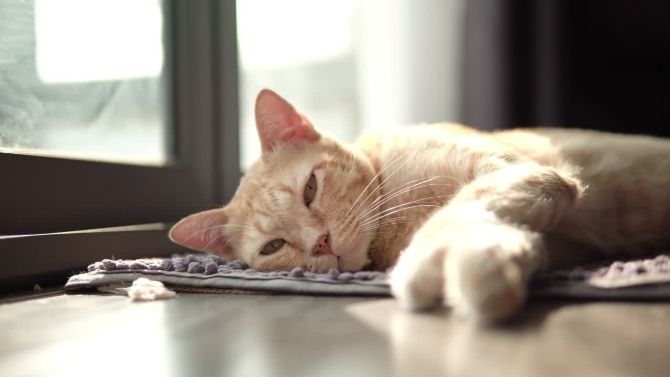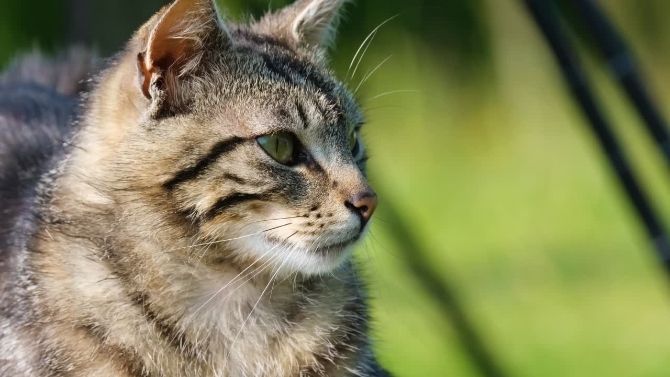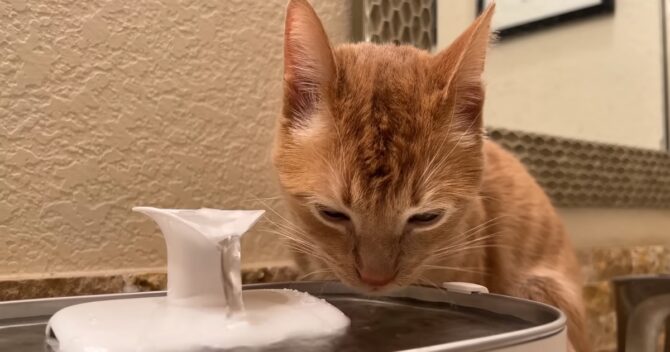Before I had a puppy, I was a proud owner of a cute friendly cat named Lily. I fondly remember the joy and warmth my feline companion brought into my life. Every purr, playful chase, and even those 3 AM “zoomies” that rattled the entire house are moments I’ll always cherish.
With its quirky personality and loving nature, Lily became an integral part of my family. And like every beloved family member, I often found myself wondering – how much time do I really have with them?
If you’re anything like I was with my Lily and you want to seize the day with your lovely pet friend, in this comprehensive guide, I’ll explore the average and maximum life expectancy of cats, offering insights that might help you use the time you have with them in the best possible way.
Feline Lifespans
Just as with humans, cats have varied lifespans based on numerous factors.
Natural Lifespan vs. Domestic Lifespan
Cats in the wild face different challenges than their domesticated counterparts. Natural predators, diseases, and harsh environments play a significant role in the shorter lifespan of feral cats, which averages between 2-5 years.
In contrast, domestic breeds are shielded from many of these threats. With proper care, they often enjoy a life ranging from 12 to 16 years, with many reaching their early twenties.
However, it’s important to remember that these are just averages. With advances in veterinary medicine and improved awareness about cat health and nutrition, many domestic cats are now living longer, healthier lives. Some even surpass the age of 20!
Factors Influencing Longevity

Genetics plays a pivotal role in determining a cat’s lifespan. Some breeds are known to live longer than others. For example, Siamese and Manx cats are often noted for their longevity.
Environmental factors, such as diet, exercise, and overall care, can also significantly influence a cat’s life expectancy. Those who are regularly vet-checked, vaccinated, and neutered or spayed tend to live longer. Moreover, the living environment itself is crucial.
An indoor cat is less exposed to external threats such as traffic, predators, and diseases from other animals. Therefore, keeping your feline friend indoors or ensuring they have a safe outdoor environment can contribute immensely to their longevity.
Life Stages of Cats
Cats go through distinct life stages, each characterized by specific developmental and health changes. Recognizing these stages helps their owners provide the best care possible.
Kitten (0-1 Year)
The first year of a cat’s life is marked by rapid growth and development. This period sees them transition from helpless newborns to independent and playful young cats.
During these early months, kittens require a high-protein diet to support their growth, along with regular vaccinations to safeguard against common feline diseases. Socialization is also vital during this stage.
Positive interactions with humans, other cats, and various environmental stimuli can lead to well-adjusted adult cats. Early experiences can significantly shape a cat’s future temperament and behavior.
Prime (1-6 Years)
Once a cat reaches one year of age, it enters its prime years. These are the equivalent of humans late teens to early thirties. Cats in this age bracket are typically robust, active, and in peak physical condition.
They’re also highly curious, making it essential for cat owners to provide ample stimulation in the form of toys, interactive play, and safe outdoor activities. While cats in their prime generally enjoy good health, regular veterinary check-ups are still vital.
Preventative care can detect and address potential health issues before they become severe.
Senior Cats & Their Golden Years

As with all living beings, cats inevitably age. The senior years of a cat’s life present new challenges, but with attentive care, they can be just as fulfilling.
Mature (7-10 Years)
During this stage, cats might start showing subtle signs of aging. While they’re still active and alert, their metabolism may slow down a bit, leading to weight gain. Adjusting their diet and ensuring they receive regular exercise can help mitigate this.
Regular health screenings become even more critical as they approach their senior years. Early detection of common age-related issues such as diabetes, kidney problems, and arthritis can lead to more effective treatments and better quality of life.
Geriatric (10+ Years)
Cats in their geriatric phase require extra TLC. They might become more prone to illnesses and might also show cognitive changes. It’s not uncommon for older species to experience vision or hearing loss, so adapting their living environment to accommodate these changes can be beneficial.
Comfort becomes a priority. Soft bedding, easy access to their favorite spots, and perhaps even some senior-specific toys can make their golden years truly golden.
Regular vet visits, a tailored diet, and lots of love ensure that our elderly feline companions feel cherished every single day.
Breed-Specific Lifespans
| Breeds | Lifespan | Characteristics | Health Considerations | Care Tips |
|---|---|---|---|---|
| Siamese & Oriental Breeds | Late Teens to Early 20s | – Active and vocal – Strong personalities – Prone to genetic health issues |
– Genetic issues like dental and respiratory problems – Regular vet check-ups for early detection and management |
– Balanced diet – Regular interactive play – Regular vet check-ups |
| Persian & Himalayan Breeds | 12-17 years | – Luxurious coats – Gentle personalities – Brachycephalic structure |
– Susceptible to respiratory and dental issues – Regular grooming for coat maintenance and skin health |
– Regular grooming – Dental hygiene – Prevent hairballs – Regular vet check-ups |
| Maine Coon | 12-15 years | – Large and sturdy – Friendly and sociable – Semi-long hair |
– Genetic heart and kidney issues – Monitor for obesity and joint problems |
– High-quality diet – Regular exercise – Regular vet check-ups |
| Ragdoll | 12-17 years | – Docile and affectionate – Blue eyes and semi-long hair – Relaxed temperament |
– Prone to obesity and heart problems – Dental care is crucial |
– Interactive play – Dental hygiene – Prevent obesity – Regular vet check-ups |
| Bengal | 12-16 years | – Wild appearance with leopard-like spots – Active and playful – Energetic |
– Potential for kidney disease and heart issues – Monitor for dental problems |
– Enriched environment for play – Regular vet check-ups – Dental care – Balanced diet |
Lifestyle & Longevity

Just like in humans, a cat’s lifestyle can greatly influence its health and longevity.
The Importance of Diet
A cat’s diet directly affects its health. Cats are obligate carnivores, meaning meat is essential for their diet. A balanced intake of protein, vitamins, and minerals ensures they remain active and healthy. As they age, their dietary needs can change.
Senior species might require food that’s easier to digest, while kittens need nutrient-rich food for growth. Avoiding overfeeding is equally important. Obesity in cats can lead to numerous health problems like diabetes, arthritis, and heart issues.
It’s beneficial to consult with a vet to determine the best dietary plan for your feline friend.
Play & Mental Stimulation
Cats are curious creatures. They thrive on play and mental stimulation. Regular interactive play sessions can prevent obesity, reduce the risk of behavioral issues, and strengthen the bond between the cat and its owner.
Toys that mimic prey, like feather wands or laser pointers, are often a hit among felines. Mental stimulation is vital, especially for indoor cats. Puzzle toys, climbing structures, and even watching birds from a safe perch can keep a cat’s mind sharp.
Engaging their instincts and curiosity can lead to a happier, and potentially longer, life.
Health Monitoring & Prevention

Prevention is always better than cure, especially when it comes to our beloved cats. Regular health monitoring can detect potential issues before they escalate.
Regular Vet Visits
Routine vet check-ups are invaluable. These visits can catch early signs of diseases or potential health problems. Vaccinations, dental care, and parasite prevention are also carried out during these sessions, ensuring that your cat remains in tip-top shape.
As cats age, more frequent visits might be required. Blood tests, urine tests, and other diagnostic procedures can offer a detailed insight into a cat’s health, allowing for timely interventions when needed.
Signs to Watch For
Even with regular vet visits, it’s essential for cat owners to be vigilant. Changes in behavior, appetite, or litter box habits can signal underlying issues. Lethargy, excessive drinking or urination, unexplained weight loss or gain, or visible signs of discomfort are red flags.
Being proactive and seeking veterinary advice when these signs appear can make all the difference. Early detection often results in better outcomes and can extend a cat’s life.
FAQs
Are mixed-breed cats generally healthier than purebred species?
It’s a common belief that mixed-breed cats (often referred to as “moggies”) have a broader genetic pool, which may make them less prone to specific breed-related health issues. While this can be true, it doesn’t necessarily mean they are always healthier than purebreds.
Both mixed-breeds and purebreds can experience health issues, but the types of problems might differ based on genetics.
How can I determine my cat’s age if I adopted them and their age is unknown?
Vets can estimate a cat’s age based on physical indicators like teeth condition, eye clarity, muscle tone, and the cat’s overall energy levels. For instance, a cat with clear, bright eyes and white teeth is likely younger, while one with some dental wear and a bit of cloudiness in their eyes might be middle-aged or older.
Do male or female cats generally live longer?
Both male and female species have the potential to live long lives, especially when neutered or spayed, which can prevent certain health issues related to reproduction.
However, some studies suggest that female cats might have a slight edge in longevity, but the difference is generally not significant enough for a definitive conclusion.
Does the size or weight of a cat play a role in its lifespan?
While cats don’t have as significant a size variation as dogs, their weight can influence their health. Obesity can lead to various health problems like diabetes, joint issues, and heart diseases, potentially reducing a cat’s lifespan.
It’s essential to ensure cats maintain a healthy weight through diet and exercise.
How do I know if my elderly cat is nearing the end of its life?
Aging cats may show signs like increased lethargy, reduced appetite, weight loss, or behavioral changes. While these can be part of the natural aging process, they can also indicate health issues.
Regular vet check-ups and discussions about your senior cat’s health can provide clarity and guidance during their golden years.
The Bottom Line

Having walked the journey with my own feline friend from her playful kitten days to her serene senior moments, I understand the importance of cherishing every moment.
Knowing more about their lifespan not only prepares us for their journey but also equips us to offer them the best life possible.
By ensuring their health, happiness, and well-being, we can make the most of the time we have with them and create lasting memories.




